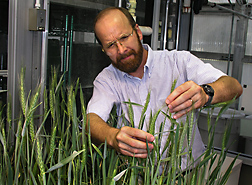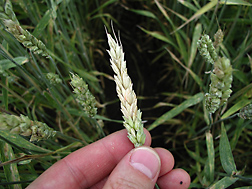Flower Power–Bacteria Style–Checks Fungal Foe of Wheat
|
|
Flower-dwelling bacteria could soon join the fight against Fusarium graminearum, the fungus that causes Fusarium head blight disease, or scab, in wheat, barley, and other cereal crops.
According to David A. Schisler, a plant pathologist in ARS’s Crop Bioprotection Research Unit at Peoria, Illinois, the bacteria colonize the flower’s anthers, or pollen-making structures, which naturally exude a smorgasbord of nutrients. One of these, choline, is rich in carbon that the bacteria need for growth.
But what does the wheat plant get in return? Protection, it turns out.
In greenhouse studies and field tests conducted in Peoria and Wooster, Ohio, starting in 2002, Schisler and colleagues have shown that inoculating wheat anthers with specific choline-metabolizing bacteria helps keep scab to a minimum. Unchecked, the disease causes economic losses in wheat by crippling the growth of kernels and turning them chalky white.
The researchers aren’t sure exactly how the bacteria protect the crop, but one possibility may be tied to the fungus’s reliance on choline as a chemical signal that cues it to form a specialized tube for breaching anther tissues. By gobbling up the anthers’ choline stores, the bacteria leave less around for the fungus, depriving it of that chemical cue. “The bacteria may keep that signal from being as ‘visible’ as it would be otherwise,” says Schisler. That observation got him and colleagues thinking: “If we could cover wheat heads and anthers with organisms that use choline, could we ‘blind’ the scab fungus to this cue?”
|
|
Of 123 choline-metabolizing bacteria they isolated from wheat-field soils and tested in the greenhouse, the researchers chose 10 strains whose scab-suppression warranted further study under field conditions.
Spraying formulations of the bacteria onto plots of two commercial wheat cultivars, at the time of flowering, reduced severity of scab by as much as 63 percent. That was close to the level of disease control attained with Folicur 3.6F, the only fungicide that can currently be considered for use against scab on wheat.
A Pseudomonas species dubbed “AS 64.4” proved to be the best all-around performer. But its future as the magic bullet against scab is unlikely. More realistic would be its combination with other scab-fighting microbes, including yeasts and antibiotic-secreting strains of bacteria that Schisler’s group previously identified and patented.
So why bother with the choline eaters, then? “Because they have a different mode of action. Combining them with the other antagonists could result in a more uniform and higher level of activity against scab,” explains Schisler. Mindful of that prospect, ARS has applied for a patent on the choline eaters.
Meanwhile, Schisler’s group is collaborating with a company seeking to develop one of the yeasts as a biopesticide. That could give growers another measure of insurance against scab outbreaks, which have cost billions of dollars in losses to U.S. wheat and barley.—By Jan Suszkiw, Agricultural Research Service Information Staff.
This research was partly supported by the U.S. Wheat and Barley Scab Initiative, managed by ARS, and is part of Plant Diseases, an ARS national program (#303) described on the World Wide Web at www.nps.ars.usda.gov.
David A. Schisler is in the USDA-ARS Crop Bioprotection Research Unit, National Center for Agricultural Utilization Research, 1815 N. University St., Peoria, IL 61604; phone (309) 681-6284, fax (309) 681-6693.
"Flower Power–Bacteria Style–Checks Fungal Foe of Wheat" was published in the April 2008 issue of Agricultural Research magazine.








